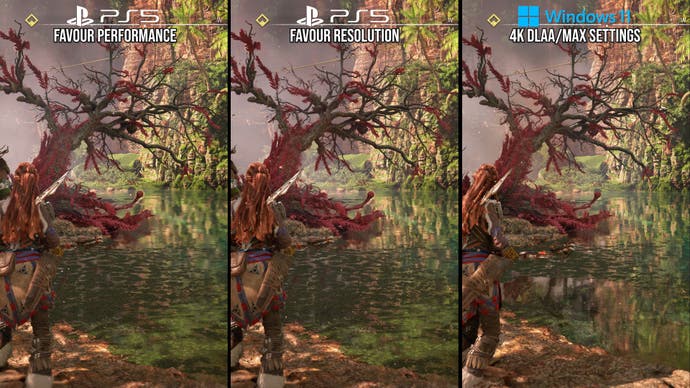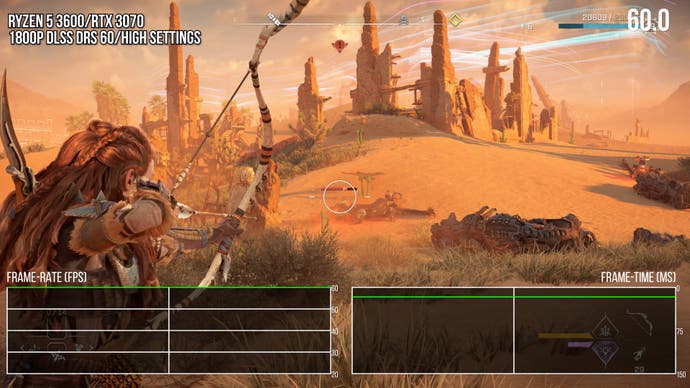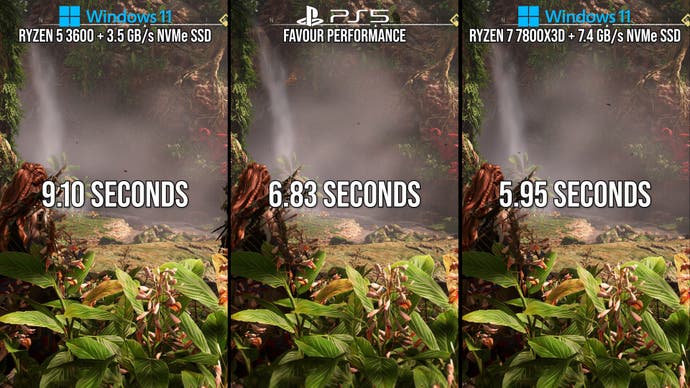One of the most technologically-advanced games on PlayStation 5 is coming imminently to PC. Horizon Forbidden West is acclaimed for its beautiful rendering and smooth performance on PS5, and we were fascinated to see how porting specialists Nixxes have adapted it to PC – and to see how accurate its (entirely reasonable) recommended specs are in-game. The studio continues to work on and refine the game up until launch, but we have had around a week with preview builds and can offer our initial impressions.
In preparing this piece, I did have time to speak with Guerrilla Games and Nixxes (and we'll be publishing an interview soon), where I was intrigued to learn that the studios are aiming for a 'console-like experience' in terms of ease-of-use and snappiness, while retaining the ability to tweak the game to your liking. And that's my first takeaway: the basics are done right. The user interface is logical and functional and changes to graphics settings are shown in real-time, allowing you to see the difference as you tweak – and come to your own conclusions about the quality increases versus the performance hits for more advanced features. Similar to other Nixxes projects, there's a wealth of upscaling options available and anti-aliasing options that include SMAA or no AA at all for the temporary anti-aliasing sceptics.
As usual, Nixxes does its best to accommodate the most popular PC options, including ultrawide support – and a 21:9 aspect ratio is a great fit for Horizon's expansive views. The ability to turn off letterboxing during cutscenes is also impressive. Elsewhere, there's also a snappiness in terms of loading times too, where a high-end PC with a fast NVMe drive running at PS5-equivalent settings is comparable with the rapid experience on console. This is aided by DirectStorage, although GPU decompression isn't enabled. At present, the developers feel this feature is too restrictive in terms of mixing and matching decompression formats and isn't quite the finished article. We're told that as Horizon isn't heavily CPU-limited, it makes sense to run decompression on the CPU rather than adding additional burden to the GPU.
Horizon Forbidden West PC vs PS5: Enhanced Features, Performance Tests + Image Quality Boosts!
Either way, the frame-time issues we saw with GPU-based DirectStorage in Ratchet and Clank are not visible here – and while we're on the topic of stutter, it's good to see that the initial load of the game is accompanied by a shader precompilation step. It takes about a minute on a venerable Ryzen 5 3600 processor, and just under half that on a top-of-the-line Ryzen 7 7800X3D. Here your PC is compiling compute shaders used for procedural vegetation placement in the game world, with more shader compilation occurring in-game in the background on spare CPU cores. The end result is that even on my Ryzen 5 3600 system, I didn't see any PSO stuttering – though, of course, it can't be completely ruled out. Generally though, based on my testing so far Forbidden West on PC offers a smooth gameplay experience.
Actual upgrades over the PlayStation 5 version are somewhat more conservative than, for example, Ratchet and Clank: Rift Apart. Where there are boosts, it's mostly about increasing sample counts or the quality of the game's various effects. Take anisotropic filtering, which runs at 2x, 4x or 8x based on the surface on PS5. Of course, PC ramps up to 16x with much better texture quality the further you go into the distance. Level of detail and terrain quality are also improved, with more detailed brush and level geometry.
Beyond that, the upgrades are less obvious. For example, PC unlocks full-quality depth of field across the board, while it is only used in cinematics on PS5. Realistically though, you'll be squinting to tell the difference between PS5's quality mode and the maxed-out experience on PC – and it's actually the 16x texture filtering option that provides the most noticeable improvement in terms of visual features.
Manage cookie settings
However, image quality is a different matter, thanks to better PC options in terms of effective resolution and anti-aliasing – especially when compared to PS5's performance mode, which uses both checkerboard rendering and a dynamic resolution to target 1800p. However, this solution is quite a downgrade against native 1800p and, in general, the console version is less clear and stable than the same resolution on PC. Indeed, native 1440p or 1440p DLSS resolves more detail than PS5's performance mode. With that in mind, users can tap into higher-quality upscaling in combination with the PC version's dynamic resolution system and achieve great results.
When setting the PC version to a dynamic 1800p with DLSS using an RTX 3070, image quality is markedly superior to PlayStation 5's performance mode – but then, you might expect that from a GPU of this class. Beyond that then, I tried an RTX 2070 Super running at dynamic 1440p with DRS and found that, although a touch blurrier than PS5's 1800p checkerboard performance mode, more detail was resolved. The basic point I'm trying to make here is that good image quality is easily attained in this port.
On top of image quality upgrades, there are also performance upgrades on PC. 120fps – whether achieved via brute force or via DLSS 3 – is another palpable improvement over the console experience. The question is whether your PC has the horsepower to do so, which brings us onto the topic of Nixxes' recommended settings. In general, I think they are fine – with one caveat. To achieve the targets set out in the spec sheet, dynamic resolution scaling is required for consistency.


The specs say that an RTX 3070 can achieve 1440p at 60fps at high settings – but even in the game's opening areas, you're actually in the 50s. That's fine for VRR displays of course, but only with dynamic resolution scaling (which is engaged by default) do you get closer to a sustained 60fps. Of course, the console version is using DRS too – and checkerboard rendering – to hit its own 60fps target. It works there quite well and I highly recommend using it on PC too to maximize performance and graphical quality.
I'd suggest targeting a specific frame-rate and pairing it with the best upscaling solution your PC is equipped with: DLSS, XeSS or FSR2, in that order. DRS goes down as low as 50 percent of native resolution, constantly adjusting in small increments to keep your GPU pegged as close as possible to full utilization.
Next up, let's talk about graphics cards with 8GB of VRAM – a setup that hobbled many recent PS5 to PC ports on launch. At 1440p, both the RTX 2070 Super and RTX 3070 had no issues with frame-rate drops due to VRAM running out. I also tried bumping up the resolution to 1800p with the RTX 3070 and found that after a cutscene, during a cutscene, or after fast traveling, I could see big frame-rate drops and swings as VRAM was overfilled and the game started paging to system memory. Instead of degrading texture quality, the Nixxes system for VRAM management keeps textures at high quality, but is forced to pull them from system memory at times. Unless this is changed in the future, I recommend 8GB GPUs play at a maximum of 1440p if they are using the high texture setting. If going higher-res, the medium texture setting looks competent visually and did not have the same performance pitfalls in my experience.


In terms of CPU performance, I was wondering if I could achieve a console-equivalent 60fps using a (now) lower-end Ryzen 5 3600. We're CPU-limited above 60fps, but surprisingly, despite that, frame-times were still smooth – and it's possible to get a good experience here, even at high settings. Only in the game's heaviest scenes, such as certain cutscenes or larger combat encounters, were we CPU-limited under 60fps.
This is perfectly reasonable given the age of the CPU in question (it's getting on for five years old!), but I was actually really impressed by frame-time consistency under load – typically, being CPU-bottlenecked is a recipe for disaster in terms of hitting and stuttering, but even the lowly Ryzen 5 3600 holds up fairly well here. Right now, the biggest issues in terms of stuttering on this CPU were limited to the initial cutscene, something I reported to Nixxes, so maybe there'll be some changes on the way.
Speaking of changes, there are some things that I would like the game to add in future updates. As of right now, there is no FSR 3 frame generation, but Nixxes has mentioned it to me – so I assume it is coming, but maybe not as a launch feature. Likewise, I would like to see slightly more dynamic resolution control with the ability to customize the top and bottom resolution if possible, and perhaps allow for finer grain frame-rate limiting above and below the refresh rate.

Lastly, if possible, I'd like to see some tweaks to strange behaviors like the occasional texture never resolving to its highest quality, or the doubling of frame-times in the intro, leading to depressed performance. These are smaller blemishes, but ones I noticed right away without even playing the PS5 version to compare.
Those are my initial thoughts on Horizon Forbidden West in its pre-launch state. It's got a lot going for it and does look like a good port with plenty of customization potential and a decent array of PC extras. Most importantly, it runs smoothly, without some of the consistency issues I saw in the launch versions of Marvel's Spider-Man or Ratchet and Clank – and general performance should satisfy users, especially if the default dynamic resolution scaling option is enabled.
We'll be back soon with a look at optimized settings and PS5-equivalent settings (think: high settings with some tweaks) but until then, let's just say that our experiences with the pre-launch code were positive and bearing in mind we were targeting 60fps with a Ryzen 5 3600 and a 2070 Super on console-equivalent settings, that hints at a good degree of scalability for lower-end kit.
#Horizon #Forbidden #West #handson #eagerly #anticipated #port